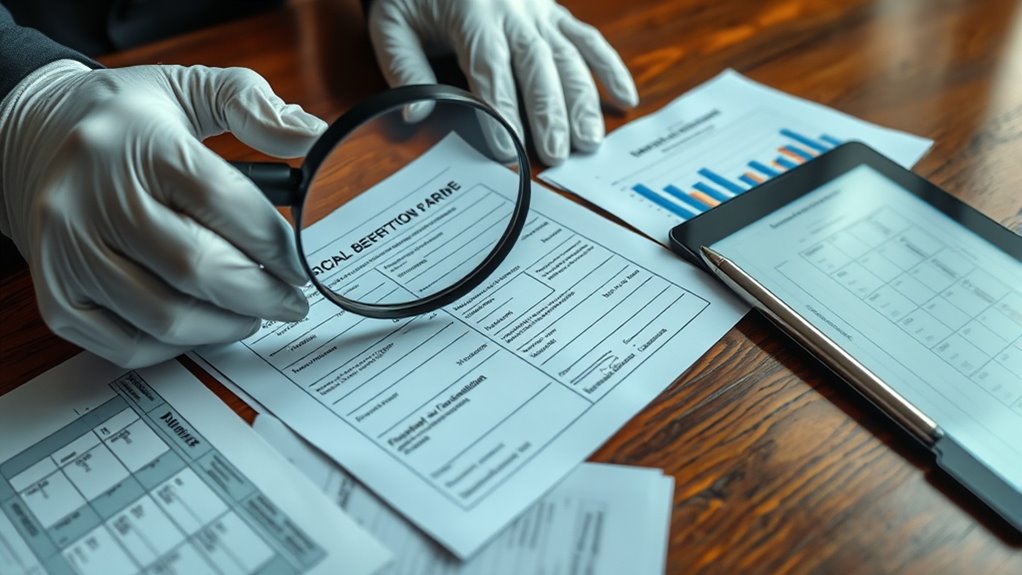To prevent benefits fraud through government document fraud, you should look for signs like mismatched personal details, altered documents, or unusual submission patterns. Use advanced tools such as OCR, security feature analysis, and machine learning to detect fake or tampered documents. Combining technology with manual review and real-time verification helps guarantee authenticity. Staying updated on policies and fraud prevention strategies strengthens your defenses, and exploring further will reveal even more effective methods.
Key Takeaways
- Implement multi-layered verification combining OCR, biometric checks, and manual review to detect forged or altered government documents.
- Utilize security features such as holograms and microtext analysis to authenticate official documents.
- Monitor submission patterns and cross-reference databases to identify suspicious activity indicating potential fraud.
- Regularly update verification protocols and employ machine learning tools for smarter, real-time fraud detection.
- Promote interagency data sharing and digital record-keeping to enhance oversight and prevent benefits fraud.
Understanding Common Types of Document-Based Fraud

Understanding common types of document-based fraud is essential because these schemes often serve as the foundation for more complex identity crimes. You need to recognize the most frequent fraud tactics to prevent them effectively. One common method involves submitting fake or altered documents, such as forged birth certificates, driver’s licenses, or Social Security cards. Another tactic is the use of synthetic identities, where fraudsters combine real and fake information to create a fictitious persona. Sometimes, individuals submit stolen genuine documents, like stolen IDs or fraudulent pay stubs, to support false claims. These schemes often slip through initial checks before escalating into larger issues. By understanding these common fraud types, you can better identify suspicious documents and strengthen verification processes to prevent unauthorized access and false benefits claims. Additionally, leveraging digital platforms can help in monitoring and identifying patterns associated with document fraud, which is crucial for maintaining integrity of benefit programs. Applying advanced verification techniques can further enhance detection capabilities and reduce the risk of fraud.
Key Indicators of Potential Document Fraud in Benefits Applications

Identifying potential document fraud in benefits applications requires keen attention to specific warning signs that often indicate deception. Look for inconsistencies or anomalies in submitted documents, such as mismatched information, altered images, or unusual formatting. Suspicious patterns include multiple applications with similar details or documents issued from inconsistent sources. Here’s a quick guide:
| Indicator | What to Look For | Why It Matters |
|---|---|---|
| Mismatched Personal Info | Inconsistent names or SSNs | Possible identity theft |
| Altered or Tampered Docs | Signs of modification or damage | Fabrication or forgery |
| Unusual Submission Patterns | Multiple claims from same IP or device | Fraudulent activity clustering |
Stay alert to these signs, as recognizing them helps prevent fraudulent claims from slipping through.
Technologies and Strategies for Detecting Fake Documents

Advancements in technology have revolutionized how government agencies detect fake documents, enabling more precise and efficient verification processes. You now have access to powerful tools that can identify counterfeit or altered documents quickly. These include:
Technological advances now enable precise, efficient detection of counterfeit documents, safeguarding government benefits effectively.
- Optical Character Recognition (OCR): Converts printed text into digital data, allowing automated checks against official records.
- Security Feature Analysis: Uses specialized scanners to verify holograms, watermarks, and microtext embedded in authentic documents.
- Machine Learning Algorithms: Analyze patterns and flag anomalies that indicate potential forgeries or alterations. Security features, such as holograms and microtext, are crucial indicators that these technologies can verify accurately. Incorporating document standards can further improve the reliability of these detection methods. Implementing verification protocols ensures consistent and thorough checks across different document types. Additionally, standardized procedures are essential for maintaining high accuracy and reducing false positives during verification processes.
- Incorporating regional legal resources can enhance the understanding of document standards specific to different jurisdictions.
Together, these strategies help you catch fake documents early, reducing fraud risks. They streamline verification, minimize human error, and increase overall accuracy in confirming document authenticity—crucial steps in safeguarding government benefits.
Best Practices for Verifying Identity and Authenticity

To effectively verify identity and authenticity, you should implement a multi-layered approach that combines technological tools with procedural checks. Start by utilizing advanced identity verification software that cross-references government databases, biometric data, and document scans to detect inconsistencies. Always follow up with manual reviews—comparing photos, signatures, and personal details against original documents or known records. Incorporate real-time validation through secure online portals or live verification calls to confirm the applicant’s identity. Implement strict controls around data entry and access, ensuring only authorized personnel handle sensitive information. Regularly update verification protocols to stay ahead of emerging fraud tactics. By combining these technological and procedural measures, you create a robust defense against fake identities and document fraud, safeguarding government benefits.
Policy Initiatives and Future Directions in Fraud Prevention

Policy initiatives are increasingly focusing on strengthening fraud prevention through technological enhancements and tighter regulatory frameworks. You’ll see more investments in advanced identity verification tools, like biometric authentication and real-time risk analysis. These efforts aim to detect synthetic identities and SSN mismatches early. Additionally, regulations now emphasize digital record-keeping and electronic eligibility tracking to reduce errors and fraud. Incorporating yoga techniques such as mindful breathing and meditation can also help reduce stress and improve focus among staff involved in fraud prevention efforts. Embracing digital security measures further enhances the integrity of data management systems. Key future directions include:
- Implementing machine learning algorithms for smarter fraud detection.
- Enhancing interagency data sharing to identify suspicious activities faster.
- Expanding public reporting channels, such as fraud hotlines, to boost citizen involvement.
These measures aim to create a more secure, transparent system that minimizes fraud risks while increasing accountability across government programs.
Frequently Asked Questions
How Can Individuals Report Suspected Document Fraud Anonymously?
You can report suspected document fraud anonymously by using official hotlines or online reporting tools provided by government agencies. Many agencies offer dedicated fraud hotlines, such as the Medicare or Social Security fraud lines, where you can call without revealing your identity. You can also submit anonymous tips through secure online portals or third-party whistleblower programs. Your report helps protect the integrity of benefit programs and prevents further fraud.
What Are the Legal Consequences of Committing Document-Related Benefits Fraud?
You risk a storm of legal consequences when committing document-related benefits fraud. Authorities release their fury with hefty fines, prison sentences, and a permanent stain on your record. You could face years behind bars, like a shadow cast over your future, and be forced to pay back stolen benefits, draining your finances. The system’s watchful eye never sleeps, ready to pounce on any deception, leaving you in the cold grip of justice.
How Effective Are Current Technologies in Identifying Sophisticated Fake Documents?
Current technologies are quite effective at detecting sophisticated fake documents. You benefit from advanced tools like biometric verification, machine learning algorithms, and real-time database checks that identify anomalies and inconsistencies. These systems analyze security features, digitize document verification, and flag suspicious activity quickly. While no system is perfect, combining multiple detection methods markedly reduces the risk of accepting fake documents, making it harder for fraudsters to succeed.
What Training Do Staff Members Receive for Detecting Document Fraud?
You receive extensive training designed to sharpen your skills in detecting document fraud, much like a seasoned detective honing their craft. This includes advanced workshops on spotting counterfeit documents, recognizing subtle inconsistencies, and understanding evolving fraud schemes. You learn to use specialized tools and technology, stay updated on the latest fraud tactics, and follow strict verification protocols—empowering you to protect crucial government benefits from sophisticated deception.
Are There Specific Document Types More Commonly Targeted in Benefits Fraud?
You should know that certain document types are more frequently targeted in benefits fraud. Social Security Numbers (SSNs), birth certificates, and proof of income documents are prime targets because they verify identity and eligibility. Fraudsters often manipulate or forge these documents to access benefits illegitimately. Staying vigilant for inconsistencies or suspicious alterations in these key documents is essential for detecting and preventing benefits fraud effectively.
Conclusion
While it might seem tedious to double-check documents, catching fraud protects everyone’s benefits and maintains trust. Your vigilance helps prevent scammers from stealing resources meant for those truly in need. Remember, using advanced tech and clear policies doesn’t slow you down—it makes your work more secure and efficient. So, stay attentive and confident; your efforts make a real difference in safeguarding benefits and keeping fraud at bay.









